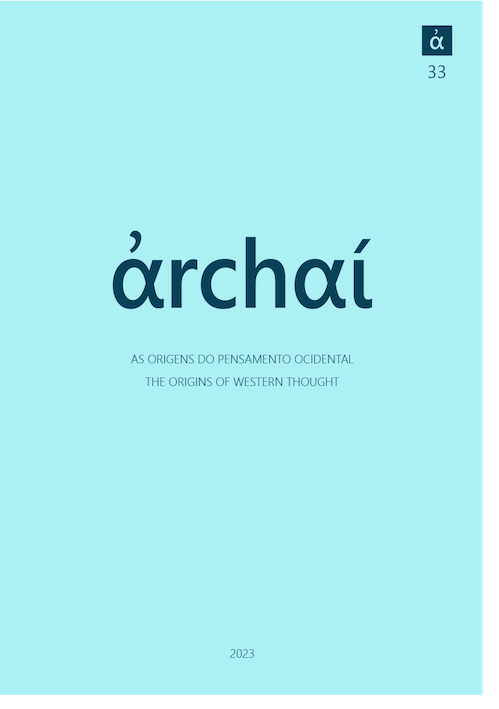On the platonic concept of to metaxy: theory of perception and cultual experience
DOI:
https://doi.org/10.14195/1984-249X_33_24Keywords:
Intermediate, Perception, Epistemology, Ontology, MythAbstract
In this paper I intend to examine the notion of intermediate in Plato´s dialogues, especially Theaetetus and Symposium. In the first section, I investigate previously in Theaetetus the notion of to metaxy as the result of mixture between percipient and perceived, by which the realm of phenomenon can be explained by the third genre, identified as to metaxy, born from a certain kind of dynamis. In the second section, I examine the mentioned notion s Symposium, expressed by Diotima of Mantineia on her encomium of Eros as daimon. My purpose in this last section is to demonstrate that the apprehension of Form of Beauty itself requires a new hermeneutic approach, which I call cultual hermeneutic, by which Plato conceives an inherent link between mythical and rational conceptions of Ideas.
Downloads
References
BERMAN, B. (2014). The Secret Doctrine and the Gigantomachia: Interpreting Plato’s Theaetetus-Sophist The Internet journal of the International Plato Society v. 14, pp. 53-62.
CORDERO, N.L. (1993). Platon. Le Sophiste Paris, GF Flammarion.
DIXSAUT, M. (2001). Métamorphoses de la dialectique dans les Dialogues de Platon Paris, Jean Vrin.
DK = DIELS, H.; KRANZ, W. (1968). Die Fragmente der Vorsokraiker Dublin-Zürich, Weidmann.
FRANCO, I.F.; TORRANO, J. (2021). Platão. O Banquete Rio de Janeiro, Editora PUC-RIO; Loyola.
IGLÉSIAS, M.; RODRIGUES, F. (2020). Platão. Teeteto Rio de Janeiro, Editora PUC-RIO; Loyola .
KAMTEKAR, R. (2009). Knowing by Likeness in Empedocles. Phronesis, v. 54, pp. 215-238.
MARQUES, M.P. (2006). Platão, pensador da diferença, uma leitura do Sofista Belo Horizonte, Editora da UFMG.
MATTÉI, J.F. (1996). Platon et le miroir du mythe, de l’âge d’or à l’Atlantide Paris, PUF.
MIÉ, F. (2004). Dialéctica, Predicación y Metafísica en Platón, Investigaciones sobre el Sofista y los diálogos tardios Córdoba, Ediciones del Copista.
MUNIZ, F. (2008). A Doutrina da Aisthesis no Teeteto de Platão. O que nos faz pensar Rio de Janeiro, PUC-Rio, v. 17, n. 24, pp. 23-33.
NIGHTINGALE, A. W. (2009). Spectacles of truth in classical greek philosophy, theoria in its cultural contexts Cambridge, Cambridge University Press.
NIGHTINGALE, A. W. (2017). The Mortal Soul and Immortal Happiness. In: DESTRÉE, P.; GIANNOPOULOU, Z. (eds.) Plato’s Symposium, A Critical Guide Cambridge, Cambridge University Press , pp. 142-159.
RACHID, R.J.R. (2020). O reverso da dialética, logos e episteme na pólis clássica. Códex, Revista de Estudos Clássicos, Rio de Janeiro, v. 8, n. 2, p. 1-25.
RACHID, R.J.R. (2021). Dýnamis koinonías: mito e dialética no Sofista de Platão. RÓNAI, Revista de Estudos Clássicos e Tradutórios, V. 9, n. 1, p. 58-81.
REID, J. (2017). Unfamiliar Voices: Harmonizing the Non-Socratic Speeches and Plato’s Psychology. In: DESTRÉE, P.; GIANNOPOULOU, Z. (eds.) Plato’s Symposium, A Critical Guide Cambridge, Cambridge University Press , pp. 28-47.
RENAUT, O. (2013). Challenging Platonic Erôs: The Role of Thumos and Philotimia in Love. In: SANDERS, E.; THUMIGER, C; LOWE, N.J. (ed.). Erôs in Ancient Greek Oxford, Oxford University Press, pp. 95-110.
RENAUT, O. (2014). Dualisme et Metaxu. Trois usages de l’intermédiaire chez Platon. Méthexis, v. 27-1, pp. 121-138.
RENAUT, O. (2018). Thumos and Doxa as intermediates in the Republic. The Internet journal of the International Plato Society . v. 18, pp. 71-82.
ROBINSON, R. (1962). Plato’s earlier dialectic Oxford, Oxford University Press .
SEDLEY, D. (2010). Plato’s Theaetetus as an ethical dialogue. In: NIGHTINGALE, A.W.; SEDLEY, D. (eds.). Ancient Models of Mind, Studies in Human and Divine Rationality Cambridge, Cambridge University Press , pp. 64-74.
TORRANO, J. (2019). Mito e imagens míticas São Paulo, Editora Córrego.
Downloads
Published
How to Cite
Issue
Section
License
Copyright (c) 2023 Rodolfo José Rocha Rachid

This work is licensed under a Creative Commons Attribution 4.0 International License.
Given the public access policy of the journal, the use of the published texts is free, with the obligation of recognizing the original authorship and the first publication in this journal. The authors of the published contributions are entirely and exclusively responsible for their contents.
1. The authors authorize the publication of the article in this journal.
2. The authors guarantee that the contribution is original, and take full responsibility for its content in case of impugnation by third parties.
3. The authors guarantee that the contribution is not under evaluation in another journal.
4. The authors keep the copyright and convey to the journal the right of first publication, the work being licensed under a Creative Commons Attribution License-BY.
5. The authors are allowed and stimulated to publicize and distribute their work on-line after the publication in the journal.
6. The authors of the approved works authorize the journal to distribute their content, after publication, for reproduction in content indexes, virtual libraries and similars.
7. The editors reserve the right to make adjustments to the text and to adequate the article to the editorial rules of the journal.



